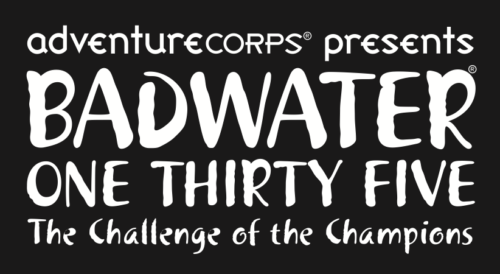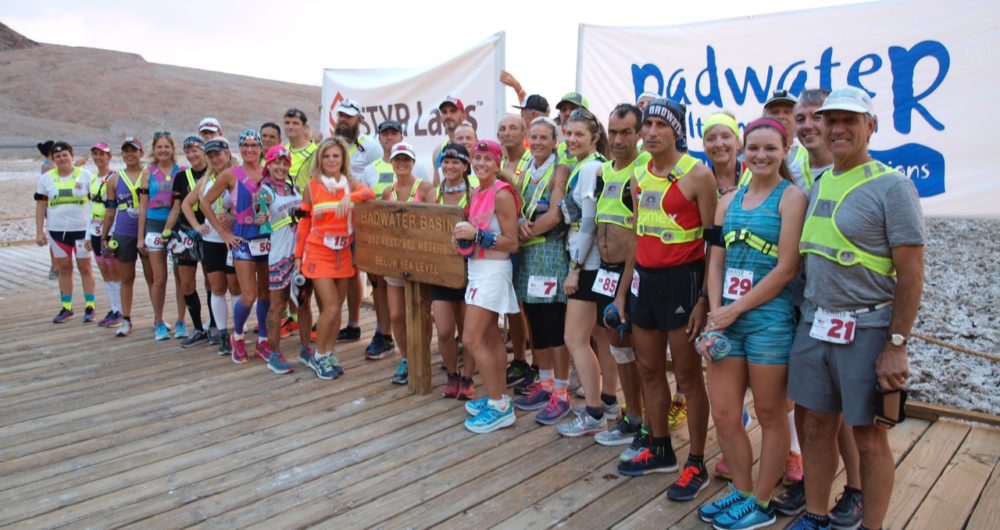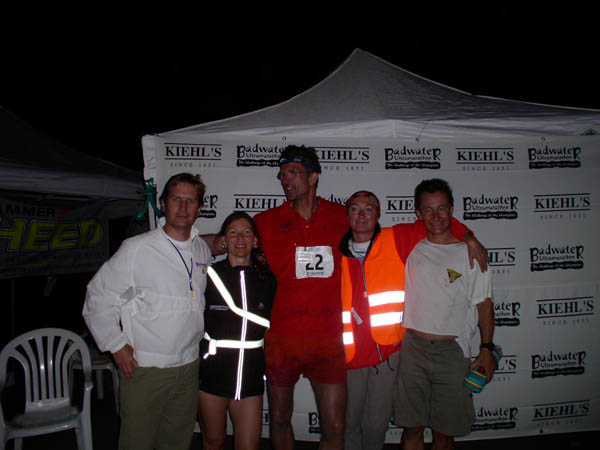THE WORLD’S TOUGHEST FOOT RACE CELEBRATES 41st ANNIVERSARY OF ICONIC ROUTE FROM DEATH VALLEY NATIONAL PARK TO MOUNT WHITNEY
To download the full Press Release, Media Kit, and Credential Application in PDF format, click here.
To download the July 2018 issue of BADWATER Magazine, click here.
FOR IMMEDIATE RELEASE
Death Valley, CA: On July 23-25, AdventureCORPS presents its legendary BADWATER® 135. Now in its 41st year, the world-renowned event pits up to 100 of the world’s toughest athletes against one another and the elements. In scorching temperatures and at altitudes as high as 8,360 feet (2548m), runners, triathletes, adventure racers, and mountaineers from 22 countries and 22 American states will face off in a grueling 135-mile non-stop run from Death Valley to Mt. Whitney, CA. Widely recognized as “the world’s toughest foot race, “ it is the most demanding and extreme running race on the planet.
The start line is at Badwater, Death Valley, which marks the lowest elevation in North America at 280’ (85m) below sea level. The race finishes at Whitney Portal at 8,300’ (2530m). The course covers three mountain ranges for a total of 14,600’ (4450m) of cumulative vertical ascent and 6,100’ (1859m) of cumulative descent. Whitney Portal is the trailhead to the Mt. Whitney summit, the highest point in the contiguous United States. Competitors travel through places with names like Mushroom Rock, Furnace Creek, Salt Creek, Devil’s Cornfield, Devil’s Golf Course, Stovepipe Wells, Panamint Springs, Keeler, Alabama Hills, and Lone Pine.
While runners began running the course in the 1970s, the race itself has been part of the fabric of life in Inyo County since 1987. A recent study indicated an annual economic impact of 1.2 million dollars, half of it spent in Death Valley National Park and surrounding gateway communities such as Lone Pine, CA. The race is supported by U.S. Congressman Col. Paul Cook (Ret.) of California’s 8th District, the Inyo County Board of Supervisors, the Lone Pine Chamber of Commerce, and a wide panorama of businesses and charities which are positively impacted.
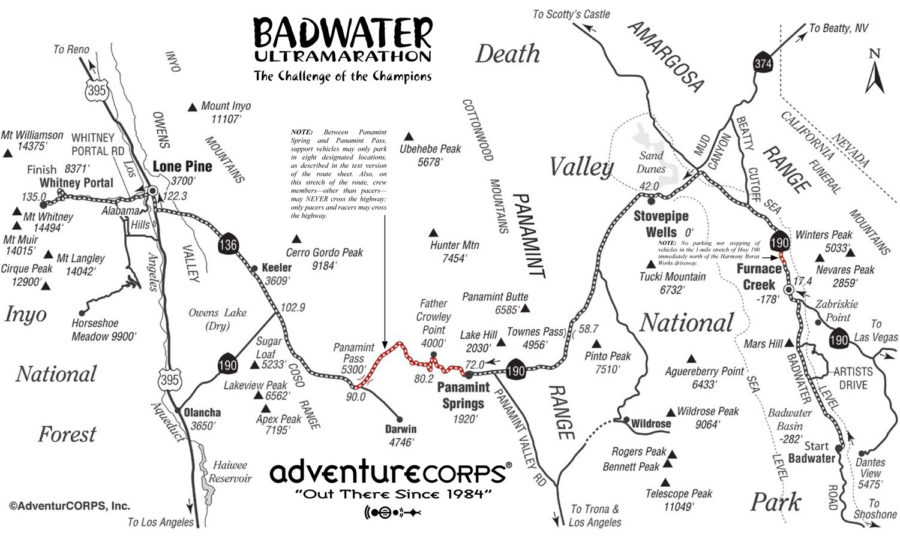
A true “challenge of the champions,” the 2018 Badwater 135 features 50 Badwater veterans and 49 rookies: die hard “ultra-runners” of every speed and ability, as well as athletes who have the necessary running credentials, but are primarily known for their exploits as adventure racers, mountaineers, triathletes, or in other extreme pursuits.
With one of the most international fields in race history, the athletes represent twenty-two countries: Armenia (first-ever Armenian entrant Telma Ghazarian Altoon), Australia, Brazil, Canada, Cayman Islands, Czech Republic, Greece (first ever Greek female entrant Georgia Mitsou), Hungary, India, Indonesia (first-ever Indonesian entrant Hendra Wijaya), Ireland, Italy, Mexico, Norway, Philippines, Poland, Russia, Spain, Sweden, Switzerland, United Kingdom, and United States of America.
Twenty-two different American states and territories are represented: Alabama, Arizona, California, Colorado, District of Columbia, Florida, Georgia, Illinois, Minnesota, Missouri, Nevada, New Mexico, New York, North Carolina, Ohio, Puerto Rico, Tennessee, Texas, Utah, Vermont, and Washington.
There are 32 women – a record number – and 67 men. The youngest runners are Ryan Montgomery (24) and and Kayla Delk (31). The oldest female is 62 (2016 and 2017 finisher and age group record holder Pamela Chapman-Markle of San Leon, Texas) and the oldest male is 71 (seven-time finisher Mark K. Olson of Covina, CA). The overall average age is 45. Full roster details are available here: http://dbase.adventurecorps.com/roster.php?bw_eid=85&bw=Go
Both men’s and women’s course records were broken in 2016: Pete Kostelnick, 28, of Lincoln, NE set the men’s record of 21:56:31, while Alyson Venti (now Allen), 34, of New York, NY, set the women’s record of 25:53:07. It is expected that the winners of the 2018 Badwater 135 will finish in near record time for both men’s and women’s divisions. The average finishing time is approximately 40 hours, while the overall time limit is 48 hours. For those who finish in less than forty-eight hours, their reward is the coveted Badwater 135 belt buckle. There is no prize money.
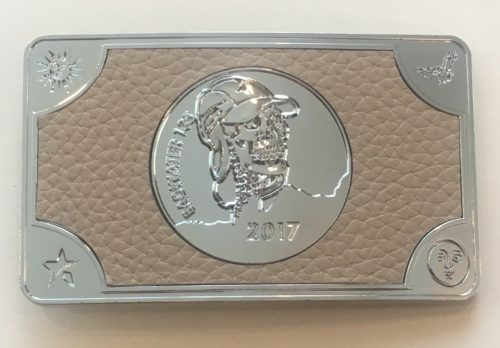
The Holy Grail of Ultra Running
The 2018 race field is particularly competitive. Veteran men’s contenders include 2015 and 2016 champion Pete Kostelnick, 30, of Hannibal, MO (who also broke the 36-year-old Trans-USA running record in 2016), 2014 champion Harvey Lewis, 42, of Cincinnati, OH (who placed 2nd in 2016), 2011 men’s champion Oswaldo Lopez, 46, of Madera, CA (Mexico citizenship), 2008 men’s champion Zach Gingerich, 39, of Newberg, OR, and other notable contenders such as multiple Badwater Salton Sea champions Jared Fetterolf, 29, of Dallas, TX and Ray Sanchez, 51, of Sacramento, CA, and two-time Badwater Cape Fear champion Eric Hunziker, 49, of Cincinnati, OH.
The largest women’s field in race history is also stacked with talent, but no recent women’s Badwater 135 champions. The women’s field of 31 runners includes 14 rookies and 18 veterans. Notable contenders include Badwater 135 veteran Brenda Guajardo who is a three-time winner of the Nove Colli ultramarathon in Italy and placed 2nd female and 10th overall in the 2016 Badwater 135, along with 2017 second place female Amy Costa and 3rd place female Pamela Chapman-Markle. With a record number of women competing – includes those with podium finishes at some of the world’s toughest ultramarathons – it will be an intense battle.
Also competing are Badwater legends Marshall Ulrich, 67, of Evergreen, CO, a twenty-time Badwater 135 finisher and four-time winner in 1991, 1992, 1993, and 1996, along with David Jones, 66, of Murfreesboro, TN, the 1997 Badwater 135 race champion, nine-time finisher, and 60+ age group record holder.
Every year is a new year at the Badwater 135, with rookies and “previously unknown” athletes surprising the contenders with top performances. New stars will shine as the race unfolds.
As detailed on the race roster, the race will begin in three waves on Monday evening, July 23:
• Wave 1 (800pm): 13 men and 18 women; 15 rookies and 16 veterans = 31 runners
• Wave 2 (930pm): 25 men and 5 women; 13 rookies and 17 veterans = 30 runners
• Wave 3 (1100pm): 29 men and 9 women; 21 rookies and 17 veterans = 38 runners
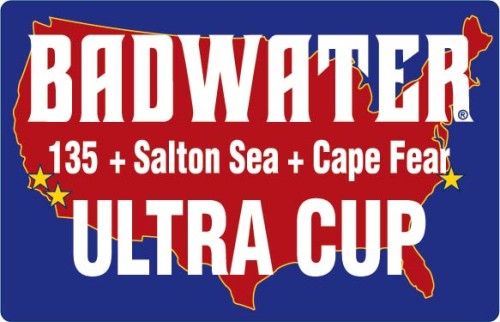 The Badwater 135 is the final event in the Badwater® Ultra Cup, a three-race series which began with the 51-mile Badwater® Cape Fear in March, continued with the 81-mile Badwater® Salton Sea in April, and now concludes with the Badwater 135 in July. Those runners who complete all three events in the same calendar year are featured on the Badwater.com website and their virtues are extolled throughout the Internet and in future editions of BADWATER Magazine. In 2014, seven athletes completed the entire Badwater Ultra Cup, nine completed the 2015 Badwater Ultra Cup, sixteen completed the 2016 Badwater Ultra Cup, fifteen racers completed the 2017 Badwater Ultra Cup, and fourteen racers have completed the first two Badwater races this year and will toe the line at this third and final Badwater race on July 23-25.
The Badwater 135 is the final event in the Badwater® Ultra Cup, a three-race series which began with the 51-mile Badwater® Cape Fear in March, continued with the 81-mile Badwater® Salton Sea in April, and now concludes with the Badwater 135 in July. Those runners who complete all three events in the same calendar year are featured on the Badwater.com website and their virtues are extolled throughout the Internet and in future editions of BADWATER Magazine. In 2014, seven athletes completed the entire Badwater Ultra Cup, nine completed the 2015 Badwater Ultra Cup, sixteen completed the 2016 Badwater Ultra Cup, fifteen racers completed the 2017 Badwater Ultra Cup, and fourteen racers have completed the first two Badwater races this year and will toe the line at this third and final Badwater race on July 23-25.
Now in its nineteenth year producing this race, AdventureCORPS greatly appreciates the support of Pure Vitamin Club, Farm to Feet Socks, Caring House Project Foundation, ZZYXXZ, Nathan Sports, Joshua Tree Products, and ZombieRunner, plus the local support of The Oasis at Death Valley, Stovepipe Wells Resort, Panamint Springs Resort, Dow Villa, Pizza Factory, the community of Lone Pine, CA, the people of Inyo County, and other generous companies and individuals. More info: www.badwater.com/about-us/sponsors/
Official Charities of the Badwater 135 include the Challenged Athletes Foundation. As one of the very few charities that provides grants directly to athletes with a physical disability, the Challenged Athletes Foundation has raised over thirty million dollars and directly assisted thousands of challenged athletes world-wide. AdventureCORPS also supports the Bald Head Island Conservancy, Death Valley Natural History Association, Conservation Alliance, and One Percent For The Planet. One of the goals of the Badwater 135 is to raise funds for, and awareness of, these organizations. More info. Additionally, many of the race entrants are competing on behalf of a charity of their choice.
This year’s race celebrates the 41st anniversary of Al Arnold’s original trek from Badwater Basin to Mt. Whitney in 1977. Arnold, an ultrarunning pioneer, human potential guru, and health club manager, competed in a solo effort: it was just Arnold and his support crew against the elements and the clock. It took him three efforts before he was successful, having first attempted the route in 1974 and then 1975. It took four more years until Jay Birmingham also completed the course, in 1981. The official head-to-head race began ten years after Arnold’s pioneer trek, in 1987, and has been held annually since then without serious incident, fatality, or any citations issued by any branch of law enforcement.
Sadly, we lost our incredible friend Al Arnold when he passed away last year on September 6, 2017 at the age of 89. When I first took over this race in 1999, Al was one of the very first people that I tracked down and went to go meet. The previous race organizers had never contacted him, so he was pleased that somebody with an appreciation of history had taken over the event and made an effort to reach out to him. We became incredible friends and stayed in touch regularly and I visited him in his home in Walnut Creek whenever possible; he would regale me with stories about his life and always cooked up a veggie burger. He had a zest for life that was incredible.
Al served on the Badwater Application Review Committee for about a decade – helping to select the race field – and also wrote yearly essays to inspire and enlighten the Badwater 135 competitors and crews. (These are permanently archived on the Badwater.com website.)
We brought Al to the race in 2002, the 25th anniversary of his run, and he was treated like a rock star by everyone in attendance. Since then, he was in regular email contact with runners all over the world, some of them Badwater 135 veterans and some were long-term hopefuls looking for advice from the man who first showed us what was possible. Just last summer, race veteran Cory Reese went to visit Al to interview him for his book about the race, “Into The Furnace.” Speaking of stories about Al, besides opening our July 2018 magazine with his obituary, we are also pleased to reprint therein the entire ten-page article from the Spring 1978 issue of Marathoner Magazine about Al’s pioneering run. What a story, what a life!
There is no doubt that Al was well loved and respected within the Badwater Family and the running world at large. He will be sorely missed, but his spirit will live on with each year’s edition of the world’s toughest foot race.
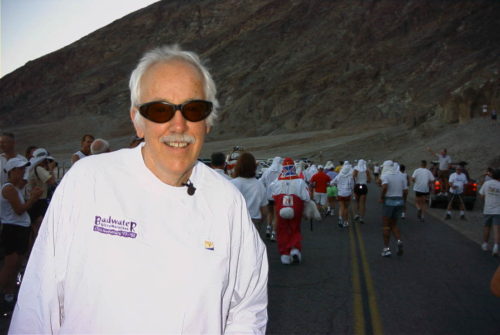
Al Arnold at the start line of the 2002 Badwater Ultramarathon.
For more info about Al Arnold and also the original race click these links:
1977 Al Arnold: http://www.badwater.com/blog/category/al-arnolds-insights/
1987 Race: http://www.badwater.com/blog/1987-the-year-badwater-became-a-race/
WEBCAST, RACE UPDATES, PRESS CREDENTIALS, AND FURTHER INFO:
A stock image gallery – for bona fide media use only – may be accessed at the following link, with Photographer Name / Badwater.com attribution required: www.flickr.com/photos/chriskostman/sets/72157654693333871
For the duration of the 2018 race, fans can follow the race through a “live” webcast – including live GPS tracking of all racers – at http://www.badwater.com/2018-badwater-135-webcast/
The Badwater 135 is held under permits from Death Valley National Park, California Department of Transportation, Inyo National Forest, and Inyo County. Media and/or commercial photographers attending the event may be required to obtain permits from some of those same agencies.
FOLLOWING THE BADWATER 135 ONLINE
Follow the 2018 webcast at (including real-time GPS tracking of all runners) at this link.
Follow the 2018 time splits and results at this link.
Follow the race on Twitter @Badwater:
Official Hashtag: #Badwater135
Follow the race staff’s live photostream on Instagram @BadwaterHQ:
http://instagram.com/badwaterHQ
Follow the race director’s live photostream on Instagram @ChrisKostman:
http://instagram.com/chriskostman
Follow the race staff’s photostream archive on Flickr:
http://www.flickr.com/photos/adventurecorps/
Follow the race director’s photostream archive on Flickr:
http://www.flickr.com/photos/chriskostman/
Join the Facebook conversation:
http://www.facebook.com/badwater135
Download the July 2018 issue of BADWATER Magazine at this link.
Download the 2018 press kit at http://www.badwater.com/wp-content/uploads/2018/07/2018-Press-Kit.pdf
ABOUT ADVENTURECORPS, INC.:
Oak Park, CA-based AdventureCORPS®, Inc. is an athlete-run firm producing and promoting ultra-endurance sports events and the world’s toughest brand, BADWATER®. Adventure is our way of life. AdventureCORPS’ world-class events for athlete-adventurers include epic races such as the Badwater® 135, BADWATER® Salton Sea, and BADWATER® Cape Fear, and other events. Our products include the Badwater® line of apparel, skin care products, gear, and services. Founded in 1984 by Chris Kostman, this group effort is dedicated to exploring the inner and outer universes, seeking adventure, energy, and insight both in daily life and “out there.” More info is available at www.adventurecorps.com and www.badwater.com.
Badwater® is a federally registered trademark owned by AdventureCORPS, Inc.
CONTACT:
Chris Kostman
Chief Adventure Officer and Race Director
AdventureCORPS, Inc. 638 Lindero Canyon Road, #311
Oak Park, CA 91377 USA
